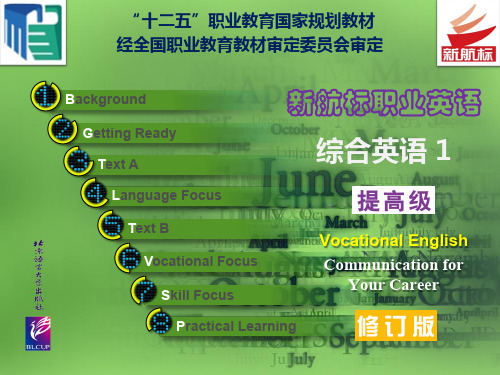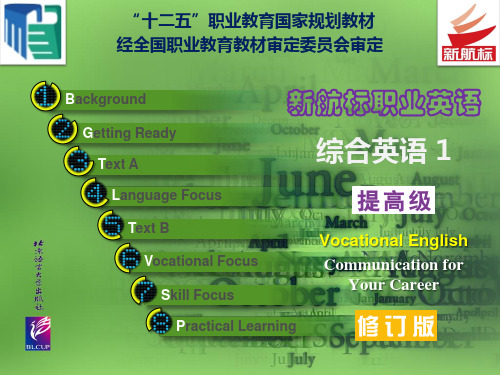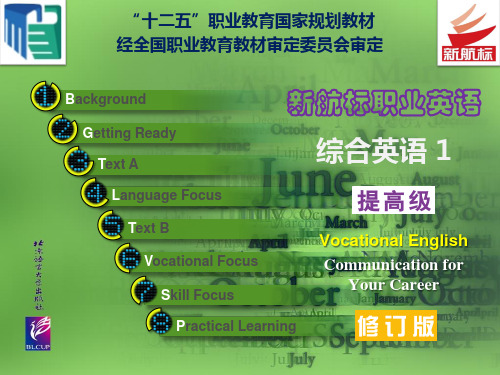新航标职业英语综合英语Unit
- 格式:ppt
- 大小:6.68 MB
- 文档页数:94






《新航标职业英语·综合英语基础级1》Unit1Lesson Plan学科 PublicEnglish班级执教者班型40课题 Unit 1:IntroductionsWorkshop1 & Vocabulary课时 2 节次 1教学目标Students will learn …• present simple be• possessive adjectives• greetings and goodbyes• countries an d nationalities• numbers 0 — 100• to talk on the phonethey will practise ...• asking for and giving personal details• exchanging contact information教学重点1.To be able to start a conversation with a stranger2.To learn to make a good impression3.To improve ability in listening and speaking4.How to exchanging their personal information教学难点1. Countries and nationalities information2.To start a conversation with a good icebreaker3.To tell what are things appropriate and inappropriate to do when meetingpeople for the first time.4.To make Students develop the habit of speaking in English in class from thevery beginning教学方法Task-oriented teaching method, group work, presentation, brainstorming.课前准备Prepare cards with numbers 0-100 and some nations which we are ready to teach in class.Teacher prepare a brief self-introductionThe map of some capitals of famous countriesProcedure of teaching(教学过程)Teaching process(教学程序)/content of courses(教学内容)Teachers’ activities(教师活动)Students’ activities(学生活动)1.Warm up: Grammar2.Start up: The map3.Workshop1: Pleased to meet you4. Vocabulary 1.Write on board2.Show up the map3.Teacher’s brief introduction1.Prepare for theself-introductions2.Find out the capitals ofcountries on map3.Follow the teacher’sorders1. Warm up: GrammarWrite on the board:I'm ____ I study ____ I'm from ____ I'm a ____ I live in ____Introduce yourself to the students, completing the phrases so that they are true for you. Model the pronunciation for the students to repeat, focusing especially on the weak forms of from and for. Elicit Nice to meet you. Ask the students to stand up and work in pairs to introduce themselves. Call Change every few minutes so that the students form new partners. Continue in this way until everyone has spoken to everyone else. Ask the students to sit down.Then write on the board:This is ____ He/She studies ____ He/She’s from ____He/She’s a ____He/She lives in ____ Choose one student and ask the others to remember what they can and use the prompts to introduce that student. Continue until every class member has been introduced.2. Start Up: The mapFocus on the map and ask the students which countries the cities are in. Focus on the registration form.AnswersFirst name: Santiago Surname: RamosDate of birth: 18 October 1976 Occupation: computer programmer nationality: MexicanAddress: Calle Andes Nol, 892 Piso 3, 111000 Montevideo Show the mapPlay the listening materialsTake answers from the students, butdon’t give the correct answers atthis stage.Check the students know themeanings of the headings Firstname, Surname, Date of birth,Occupation, Nationality andAddress. Tell the students they aregoing to listen to Santiago arrivingat a conference and they have tocomplete the form. Play the audioonce or twice, then check theanswers.Find the capital ofcountriesListen and find out thecountries3. workshop1: Pleased to meet youInterview another student and complete the registration form. Begin like this: Can I ask you some questions? Yes, of course. Play the audio again once or twice to give the students the chance to complete the questions (you might want to stop after every second sentence), then check the answers.Present simple be be动词的一般现在时Full form 完整形式 Short form 缩略形式Example:You: Hello, I’m Paul. Nice to meet you. S1: I’m Sergio. Good to meet you, too. You: Where are you from, Sergio?S1: I’m from Chile.You: What’s your job?S1: I’m a sale s representative.You: Silvia, this is Sergio. He's a sales representative from Chile. Introduce yourself toanother student: I’m[name]. Nice to meet youDemonstrate the answerGood to meet you, too.Demonstrate with anotherstudent, then introduce athird student to them: Thisis [name], then ask them togreet each other.Demonstrate the activityby introducing yourself toanother student and askinghim/her where he/she isfrom and what his/her jobis. Then introduce thestudent to the person onyour left.Introduce yourself to theperson on your right.Ask him/her aboutwhere he/she is from andwhat his/her job is orwhat he/she is going todo in the future.Introduce him/her to theperson on your left?They should use the firsttext in 9 to help them.Encourage them to usepossessive adjectiveswhere possible. Ask afew students to read outtheir profile.Alternatively, set thetask as homework.4: VocabularyBasic vocabulary * avenue /ˈævənjuː/ n. 大街,林荫大道 He stands on the corner of a wide avenue. 他站在宽阔的林荫道的角落里。
新航标职业英语·综合英语2 Unit 61. IntroductionIn Unit 6 of the New Hangbiao VocationalEnglish · Comprehensive English 2 course, we will focus on the topic of job interviews and employment. This unit aims to provide students with the necessary language skills and knowledge to effectively navigate the job interview process and excel in their future careers.2. ObjectivesBy the end of this unit, students should be able to:•Understand and use vocabulary related to job interviews and employment•Demonstrate effective listening and speaking skills in a job interview setting•Write a professional resume and cover letter•Identify common interview questions and prepare appropriate responses•Increase their understanding of employment laws and regulations3. Lesson Plan3.1 VocabularyIn the first part of the unit, students will learn and practice new vocabulary related to job interviews and employment. They will engage in various activities, such as matching words with their definitions, completing sentences with the correct vocabulary, and participating in discussions.3.2 Listening and SpeakingIn this section, students will listen to audio recordings of job interviews and practice their listening comprehension skills. They will also engage in role plays and mock interviews to improve their speaking skills and gain confidence in a job interview setting.3.3 WritingThe writing component of this unit focuses on resume and cover letter writing. Students will learn the appropriate format and content for a professional resume and cover letter. They will also practice writing their own resumes and cover letters, receiving feedback from their peers and the instructor.3.4 Reading and DiscussionIn this section, students will read articles and case studies related to job interviews and employment. They will analyze the content, participate in group discussions, and share their opinions and experiences.3.5 Employment Laws and RegulationsTo provide a comprehensive understanding of the job interview process, this unit also covers employment laws and regulations. Students will learn about common employment laws and regulations, such as anti-discrimination laws and minimum wage laws, and discuss their implications in the workplace.4. AssessmentThroughout the unit, students will be assessed through various means, including quizzes, homework assignments, participation in discussions, and a final exam. The assessments will evaluate students’ understanding of the vocabulary, listening and speaking skills, writing skills, and knowledge of employment laws and regulations.5. ConclusionUnit 6 of the New Hangbiao VocationalEnglish · Comprehensive English 2 course provides students with the necessary skills and knowledge to succeed in job interviews and employment. By the end of this unit, students will be equipped with the language skills to effectively communicate in a job interview setting, write professional resumes and cover letters, and navigate employment laws and regulations.。